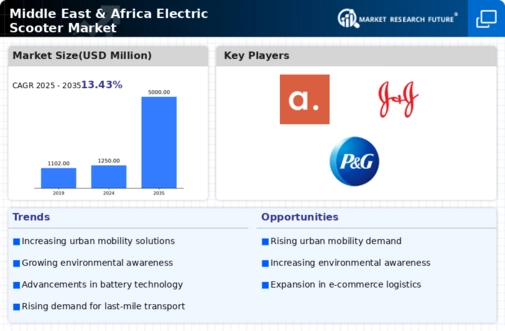Market Analysis
In-depth Analysis of middle-east-and-africa Electric Scooter Market Industry Landscape
The Middle East & Africa (MEA) electric scooter market is experiencing a surge in demand driven by various market dynamics. One significant factor contributing to this growth is the increasing urbanization across the region. As cities expand and populations grow, there's a greater need for efficient and sustainable modes of transportation. Electric scooters offer a convenient solution for short-distance travel within congested urban areas, where traditional modes of transport may be less practical or environmentally friendly.
Another key driver of market dynamics in the MEA electric scooter market is the growing awareness of environmental sustainability. With concerns over air pollution and climate change on the rise, consumers are increasingly seeking eco-friendly alternatives to conventional gasoline-powered vehicles. Electric scooters, with their zero-emission operation, appeal to environmentally conscious individuals looking to reduce their carbon footprint.
Government initiatives and policies also play a significant role in shaping the market dynamics of electric scooters in the MEA region. Many governments are implementing regulations and incentives to promote the adoption of electric vehicles, including scooters. These measures may include subsidies, tax incentives, and infrastructure development such as charging stations, all of which serve to encourage consumers to choose electric scooters over conventional vehicles.
Additionally, technological advancements are driving innovation in the electric scooter market, further fueling its growth in the MEA region. Manufacturers are continually improving battery technology, extending the range and performance of electric scooters while reducing charging times. Furthermore, the integration of smart features such as GPS navigation, app connectivity, and anti-theft systems enhances the appeal of electric scooters to tech-savvy consumers.
The competitive landscape of the MEA electric scooter market is also evolving rapidly. Both established players and new entrants are vying for market share, leading to increased innovation and product diversification. This competition benefits consumers by offering a wider range of options in terms of price, features, and design.
However, the market dynamics of the MEA electric scooter market are not without challenges. One significant obstacle is the lack of adequate infrastructure to support widespread adoption. This includes a shortage of charging stations and dedicated lanes for electric scooters, which can limit their practicality and convenience, particularly in densely populated urban areas.
Furthermore, concerns over safety and regulation pose challenges to the growth of the electric scooter market in the MEA region. Issues such as reckless riding, accidents, and conflicts with pedestrians have prompted authorities to impose restrictions and regulations on electric scooter usage in some areas. Addressing these concerns will be crucial for sustaining the long-term growth of the market.
In conclusion, the Middle East & Africa electric scooter market is experiencing robust growth driven by various market dynamics, including urbanization, environmental sustainability, government initiatives, technological advancements, and competitive forces. While the market presents significant opportunities for manufacturers and consumers alike, challenges such as infrastructure limitations and safety concerns must be addressed to unlock the full potential of electric scooters in the region.







Leave a Comment